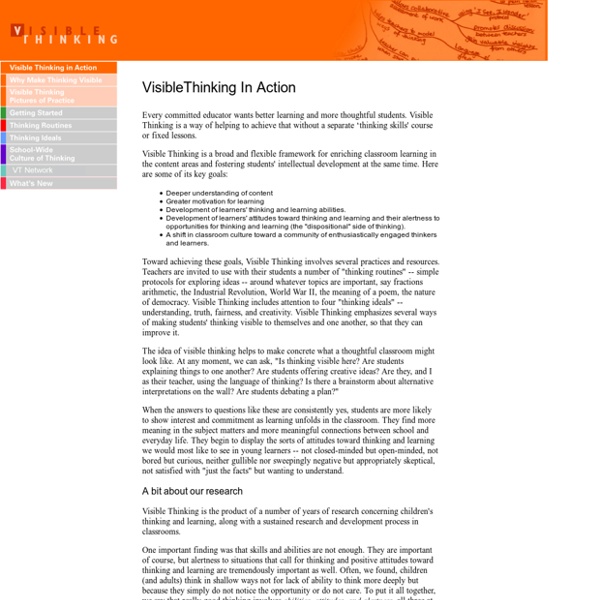Visible Thinking
VisibleThinking In Action Every committed educator wants better learning and more thoughtful students. Visible Thinking is a way of helping to achieve that without a separate ‘thinking skills' course or fixed lessons. Visible Thinking is a broad and flexible framework for enriching classroom learning in the content areas and fostering students' intellectual development at the same time. Here are some of its key goals: Deeper understanding of content Greater motivation for learning Development of learners' thinking and learning abilities. Toward achieving these goals, Visible Thinking involves several practices and resources. The idea of visible thinking helps to make concrete what a thoughtful classroom might look like. When the answers to questions like these are consistently yes, students are more likely to show interest and commitment as learning unfolds in the classroom. A bit about our research One important finding was that skills and abilities are not enough.
http://www.visiblethinkingpz.org/VisibleThinking_html_files/01_VisibleThinkingInAction/01a_VTInAction.html
Related: Vel R. Phillips lessons
• ezcam
Teaching Tolerance - Diversity, Equity and Justice
Essential Questions: What is identity?How is identity developed?How does identity affect our relationships? Objective:
Teaching Tolerance - Diversity, Equity and Justice
Objectives: At the end of the lesson, students will be able to: • identify 10 crucial global issues. • list some simple social justice actions they can take. Essential Questions: • What are some crucial global social issues facing us today?
6 Reasons to Try a Single-Point Rubric
As educators, we know the power of a good rubric. Well-crafted rubrics facilitate clear and meaningful communication with our students and help keep us accountable and consistent in our grading. They’re important and meaningful classroom tools. Usually when we talk about rubrics, we’re referring to either a holistic or an analytic rubric, even if we aren’t entirely familiar with those terms.
Teaching Tolerance - Diversity, Equity and Justice
Objectives: At the end of the lesson, students will be able to: discuss and write messages about how it feels to be grouped or identified by gender. work in groups to record and discuss messages shared with others in the class.
Teaching Tolerance - Diversity, Equity and Justice
Objectives: At the end of the lesson, students will be able to: • explain different techniques used by advertisers • analyze fashion and beauty advertisements Essential Questions:
Employability Skills Lesson Plans and Career Readiness
x Close A Guide to Career Readiness & Employability Skills Lesson Plans Career readiness and employability skills lesson plans have become an increasingly critical part of education. Employers are desperately seeking people with a combination of skills that seem to fall under this career readiness and employability umbrella that also include such things as soft skills, customer service skills and life skills. Imagine sending your students on to their career or college goals and aspirations knowing that you’ve done the very best to help them shine among their peers in whatever field they’ve chosen. That’s really what it’s all about, right?
Without Edgar Allan Poe, we wouldn't have Sherlock Holmes
When Edgar Allan Poe first introduced the world to C. Auguste Dupin, he hit on a winning formula. Dupin was Sherlock Holmes before Sherlock Holmes, a genius detective who first appeared in "The Murders in the Rue Morgue," first published in 1841. In that story, the first locked-room mystery, two women are dead and only a bloody straight razor, two bags of gold coins and some tufts of hair are found in the room with their bodies. The game's afoot, as Holmes might say (Poe didn't give Dupin a nifty catchphrase).
The Beat Within
Bay Area Focus on The Beat Within! From the Youth Leadership of America, the high school group that visited a few weeks ago. Thanks for checking in! We loved working with you, and the team creating the video here: The speaker is DeAngelo Cortijo, he has never set foot in a high school.
Related:



